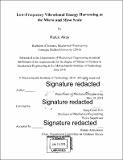Low-frequency vibrational energy harvesting at the micro and meso scale
Author(s)
Akay, Haluk (Haluk John)
DownloadFull printable version (12.03Mb)
Other Contributors
Massachusetts Institute of Technology. Department of Mechanical Engineering.
Advisor
Sang-Gook Kim.
Terms of use
Metadata
Show full item recordAbstract
Energy harvesting from environmentally available vibrations is a solution to providing electric power for remote and mobile applications, such as the Internet of Things. A buckled beam-based MEMS device can harvest power from low frequency, low amplitude vibrations which has never been achieved by a micro-scale device. Due to the poor fabricated quality of the active piezoelectric material in the device, however, the generated power has been an order of magnitude less than expected. It is important to harvest more than 1 micro Watt at the device size smaller than a coin in order to implement this technology for real world application. The buckled beam vibrational energy harvesting device has been evaluated for its power generation performance and its specific microfabrication recipe with respect to piezoelectric materials has been analyzed from a process control standpoint to identify areas of improvement. The process has been redesigned for a simpler and streamlined recipe. Complex residual stress control feedback loops have been replaced with a simple post-fabrication assembly to induce controlled buckling in active MEMS beams. Using a custom-designed fixture, the post-fabrication buckling concept has been demonstrated to achieve accurately buckled beams. With regard to mesoscale energy harvesting, a product has been designed that converts regular human walking motion to electricity. The device harvests electric power using air bulbs, distributed in the sole of a shoe to drive a series of micro-turbines connected to small DC motors. The number and position of air bulbs is optimized to harvest the maximum airflow from each foot-strike. The system is designed to continuously drive the micro-turbines by utilizing both outflow and inflow from the air bulbs. A prototype combat boot was fitted on the right foot of a 75kg test subject, and produced an average continuous power on the order of lOs of mW over a 22[omega] load during walking at 3.0 mph. This combat boot provides enough electric power to a passive GPS tracker that periodically relays geographical coordinates to a smartphone via satellite.
Description
Thesis: S.M., Massachusetts Institute of Technology, Department of Mechanical Engineering, 2018. Cataloged from PDF version of thesis. Includes bibliographical references (pages 94-96).
Date issued
2018Department
Massachusetts Institute of Technology. Department of Mechanical EngineeringPublisher
Massachusetts Institute of Technology
Keywords
Mechanical Engineering.